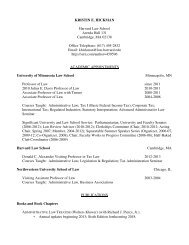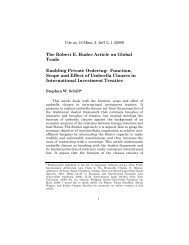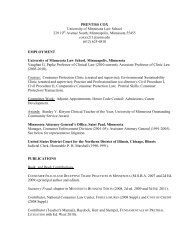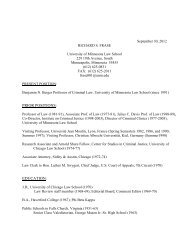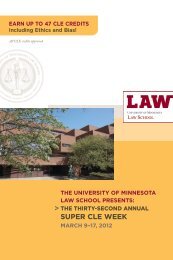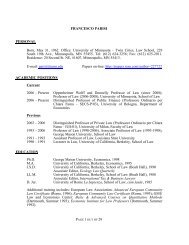The End-of-Life Vehicle (ELV) - the University of Minnesota Law ...
The End-of-Life Vehicle (ELV) - the University of Minnesota Law ...
The End-of-Life Vehicle (ELV) - the University of Minnesota Law ...
Create successful ePaper yourself
Turn your PDF publications into a flip-book with our unique Google optimized e-Paper software.
2009] END-OF-LIFE VEHICLE DIRECTIVE 455<br />
Third, national political attention may be too distracted by<br />
current economic and foreign policy issues for public<br />
consideration <strong>of</strong> waste management issues.<br />
Likewise, implementation <strong>of</strong> <strong>the</strong> technology needed for<br />
processing <strong>of</strong> waste traditionally not recycled would be costly, 180<br />
and regulation <strong>of</strong> 7,000 waste facilities would put a strain on <strong>the</strong><br />
Environmental Protection Agency and environmental agencies<br />
<strong>of</strong> various states. 181 However, given <strong>the</strong> environmental security<br />
that concise and harmonious <strong>ELV</strong> legislation would afford, in<br />
addition to <strong>the</strong> potential economic viability <strong>of</strong> <strong>the</strong>se markets 182<br />
once <strong>the</strong> lethargy <strong>of</strong> capital investment is overcome, a national<br />
scheme loosely based on international EPR models is appealing.<br />
In fact, many <strong>of</strong> <strong>the</strong> building blocks that are necessary for an<br />
effective EPR <strong>ELV</strong> management system already exist, and<br />
simply need to be aligned. 183<br />
Given its advantages, lawmakers in <strong>the</strong> United States<br />
should reconsider <strong>the</strong> issue <strong>of</strong> <strong>ELV</strong> disposal. <strong>The</strong>y should adopt<br />
minimum environmental standards that reflect <strong>the</strong> technical<br />
and economic conditions that <strong>ELV</strong> management in both <strong>the</strong> U.S.<br />
and E.U. reflect, and implement <strong>the</strong>se standards through some<br />
level <strong>of</strong> responsibility by automotive manufacturers. 184 This<br />
would ensure that <strong>the</strong> potential recyclability <strong>of</strong> new automobiles<br />
is not wasted by a lack <strong>of</strong> incentive and infrastructure. Such<br />
legislation would allow consolidated considerations <strong>of</strong> both<br />
economic efficiency and environmentally sound procedures at<br />
<strong>ELV</strong> facilities. Fur<strong>the</strong>rmore, <strong>the</strong> legislation could entail a<br />
framework for so called “white goods,” household appliances<br />
180. See generally Ogushi & Kanlikar, supra note 26, at 4507 (discussing <strong>the</strong><br />
substantial capital expenditures needed for implementation <strong>of</strong> Japanese <strong>ELV</strong> law).<br />
181. See supra Part II (discussing <strong>the</strong> EU <strong>ELV</strong> Directive).<br />
182. See, e.g., European Union Recycle Tire Test Results Announced, supra note<br />
142.<br />
183. For example, <strong>the</strong> American Recycler Association has a Certified Automotive<br />
Recycler program, which is in part based on adherence to environmental<br />
requirements. An <strong>ELV</strong> management law could effectively commandeer this system<br />
by requiring certification in order to dismantle or process <strong>ELV</strong>s. Currently, only<br />
around 200 facilities are fully certified. See Staudinger et al., supra note 4, at 38–<br />
39.<br />
184. Financial responsibility would be <strong>the</strong> easiest to implement. Manufacturers<br />
would be responsible only for <strong>the</strong> excess costs <strong>of</strong> effective <strong>ELV</strong> disposal, such that<br />
manufacturers will have an incentive to lower <strong>the</strong>se fees by technological<br />
developments and reuse <strong>of</strong> recycled material. See T<strong>of</strong>fel, supra note 21, at 12<br />
([F]inancial responsibilities will result in lower costs than those that impose<br />
physical responsibilities.”). Physical take-back responsibilities may be difficult to<br />
implement, but <strong>the</strong> EU <strong>ELV</strong> Directive suggests that if such take-back provisions can<br />
be implemented across <strong>the</strong> EU, a similar system can be created in <strong>the</strong> United States.




